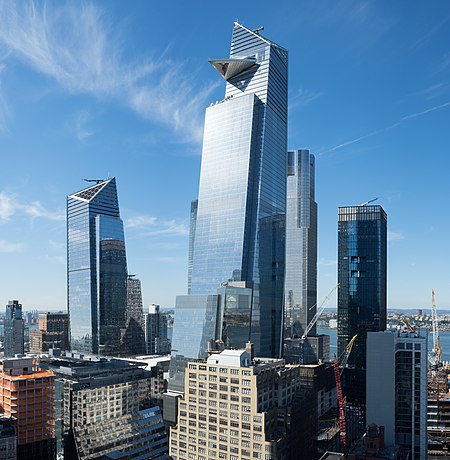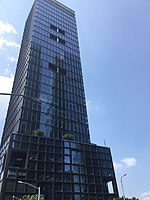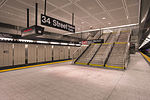Hudson Yards (development)

Hudson Yards is a 28-acre (11 ha) real estate development in the Hudson Yards area of Manhattan, New York City, between the Chelsea and Hell's Kitchen neighborhoods. Upon completion, 13 of the 16 planned structures on the West Side of Midtown South would sit on a platform built over the West Side Yard, a storage yard for Long Island Rail Road trains. The first of its two phases, opened in 2019, comprises a public green space and eight structures that contain residences, a hotel, office buildings, a mall, and a cultural facility. The second phase, on which construction had not started as of 2021, will include residential space, an office building, and a school. Related Companies and Oxford Properties are the primary developers and major equity partners in the project. Related, Oxford, and other large investors have funded Hudson Yards' construction from several capital sources, including from foreign investors through the EB-5 investment program. Mitsui Fudosan owns a 92.09 percent stake in 55 Hudson Yards, and a 90 percent stake in 50 Hudson Yards. The architectural firm Kohn Pedersen Fox designed the master plan for the site, and architects including Skidmore, Owings, and Merrill, Thomas Heatherwick, Foster + Partners, Roche-Dinkeloo, and Diller Scofidio + Renfro contributed designs for individual structures. Major office tenants include or will include fashion company Tapestry, consulting firm BCG, the new New York bureau for CNN, and urban planning organization Sidewalk Labs. The Hudson Yards site was initially intended for other developments, most notably in the early 2000s as the site of the West Side Stadium, during the New York City bid for the 2012 Summer Olympics. Public officials and private investors began developing the new Hudson Yards plan after the failure of the West Side Stadium. Construction began in 2012 with the groundbreaking for 10 Hudson Yards, and the first phase opened on March 15, 2019. Agreements between various entities including the local government, the Metropolitan Transportation Authority (MTA), and the state of New York made the development possible. The special zoning for Hudson Yards (an area roughly bound by 30th Street in the south, 41st Street in the north, 11th Avenue in the west, and Eighth Avenue in the east) further incentivized the building of other large-scale projects. Hudson Yards is adjacent but unrelated to Manhattan West, 3 Hudson Boulevard, and The Spiral.
Excerpt from the Wikipedia article Hudson Yards (development) (License: CC BY-SA 3.0, Authors, Images).Hudson Yards (development)
Public Square & Gardens, New York Manhattan
Geographical coordinates (GPS) Address Nearby Places Show on map
Geographical coordinates (GPS)
| Latitude | Longitude |
|---|---|
| N 40.754166666667 ° | E -74.0025 ° |
Address
Vessel (The Vessel)
Public Square & Gardens
10199 New York, Manhattan
New York, United States
Open on Google Maps








